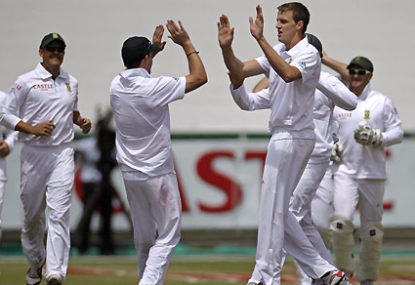If South Africa fill their new racial quota it looks set to weaken their line-up for the first Test against Australia.
Under the recently-introduced quota, the Proteas aim to field an average of at least six cricketers of colour, including two black Africans, per match.
Should the Proteas follow this policy to the letter for the Perth Test starting on Thursday it will almost certainly see pace enforcer Morne Morkel overlooked for a player of colour in Vernon Philander. There are only seven players of colour in South Africa’s squad and two of them are spinners who definitely won’t play together at Perth.
Philander floundered on his last tour of Australia, taking just four wickets at 74 from three first-class matches. On this current tour, he has the uninspiring figures of 2-85 from two matches against extremely weak teams made up mostly of guys with no first-class cricket experience.
That gives him a grand total six wickets at 64 from his five matches in Australia. Morkel, meanwhile, was the best bowler from either side the last time South Africa toured, snaring 14 wickets at 28 as South Africa won the Test series 1-0. He has backed that up with 4-94 from his two matches this tour.
To make it clear, I am not criticising the concept of South Africa’s new quota system. Nor am I suggesting the quota will leave South Africa with a poor line-up – it will remain fearsome – or that the players of colour chosen are not worthy Test cricketers.
What I am suggesting is that Australia will be delighted if Philander takes the field at Perth ahead of Morkel. While Philander has a wonderful Test record, he is not as well suited to Australian conditions as Morkel, who can hit 150kmh and earns startling bounce from his 196cm frame.
This is particularly relevant because the first two matches will be played at Perth and Hobart, both of which had uber-flat decks last summer leading to very high-scoring Tests.
The Perth Test against New Zealand saw totals of 559 and 624 in the first two innings, while the Hobart Test against the West Indies involved a 449-run partnership between Adam Voges and Shaun Marsh.
In such conditions, you need bowlers who are able to wring life out of a dead surface. This is not Philander’s speciality, but it is something Morkel has repeatedly proved capable of, including on the Proteas’ last tour of Australia, when all three Test decks were great for batting.
Morkel’s pace and height mean he can make life uncomfortable for Test batsmen even on the sleepiest of pitches. Philander, meanwhile, is phenomenal on surfaces with a bit of juice thanks to his consistency and ability to seam and swing the ball.

That makes Philander a perfect bowler to include for the third Test in Adelaide, which is expected to have a moist deck like it did last summer in order to protect the fragile pink ball.
The pitches for the first two Tests, however, if they are similar to last year, will favour pacemen who have height and/or hurrying pace.
Morkel, champion quick Dale Steyn and pace prodigy Kagiso Rabada all fit this bill. But in such conditions, Philander would be out of his element. He is one of the shortest fast bowlers in world cricket, measuring in at about 176cm, around 15 to 20cm shorter than the likes of Morkel, Rabada and Australian quicks Mitchell Starc, Josh Hazlewood and Jackson Bird.
He also operates at a gentle pace, mostly in the 127–133kmh range, which is slower than any of those aforementioned quicks. This means that, with the Kookaburra ball barely swinging in Australia and the Perth and Hobart pitches unlikely to offer seam movement, Philander could be skidding the ball through dead straight at an easy pace.
This was what happened the last time he toured Australia four years ago. Philander was not flayed by the batsmen on that tour. He just had very little penetration because of the lack of assistance from the pitches.
Among Australian Test bowlers, Philander is most similar in style to Peter Siddle. The Victorian now operates at about the same pace as Philander and, just like the South African, he relies on bowling delivery after delivery on a nagging length just outside off stump.
As a sign of what may be to come for Philander if he plays in the first two Tests, Siddle’s effectiveness at home has eroded in the past few years due to his loss of pace and the flat nature of the Australian pitches. Over the past two summers, Siddle has played four Tests, taking just nine wickets at a tick under 40.
Siddle has not bowled poorly in those Tests – he has maintained a fine line and length – but has badly lacked penetration, as evidenced by his sky-high strike rate of 72. The Victorian has one major advantage over Philander in that he earns significantly more bounce, thanks to being about 11cm taller.
As I wrote last week, Australia would dearly love to have a sharp paceman to complement Starc and Hazlewood if the pitches are flat. A bowler of Morne Morkel’s pace, bounce and ability would fit that bill perfectly.
South Africa’s likely starting XI for the first Test (if they seek to fill racial quota of six players of colour):
1. Dean Elgar
2. Stephen Cook
3. Hashim Amla
4. JP Duminy
5. Faf du Plessis (capt)
6. Temba Bavuma
7. Quentin de Kock (WK)
8. Vernon Philander
9. Kagiso Rabada
10. Dale Steyn
11. Keshav Maharaj






























































































